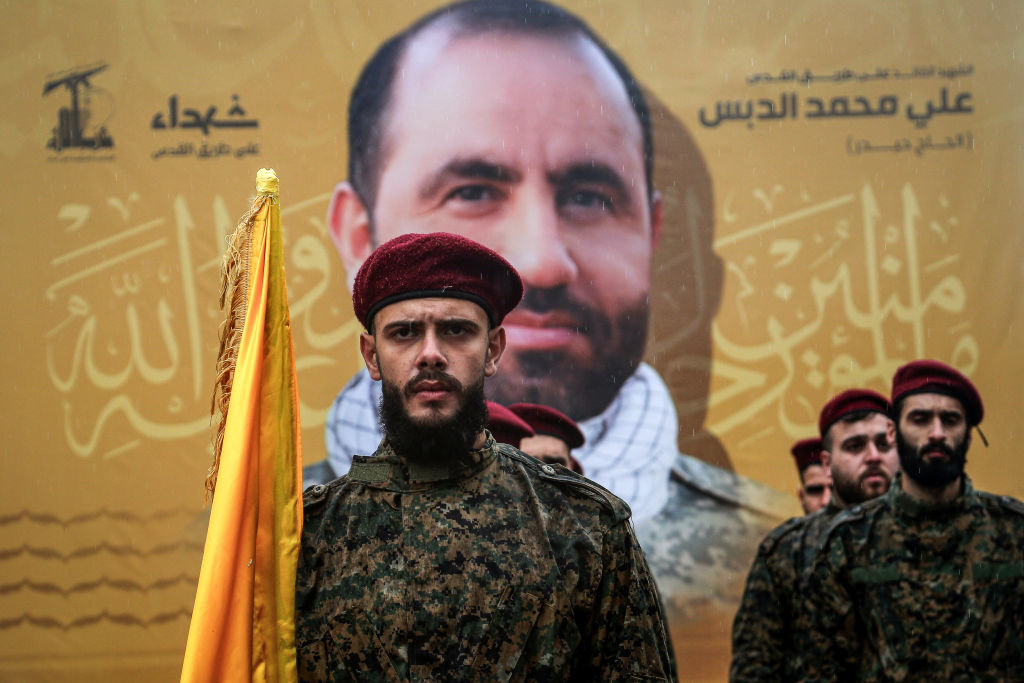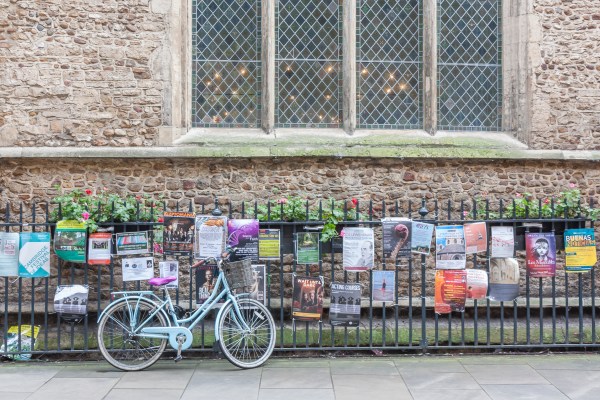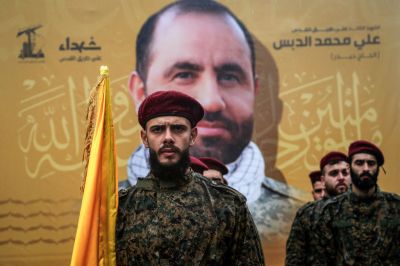The Biden administration is quietly pushing Israel into a phony political agreement with Lebanon that would deliver a strategic victory to Iran and its chief terror proxy, Hezbollah, while creating a false sense of security for the residents of northern Israel. With an American president unwilling to back the Jewish state in a war against a threat 10 times greater than Hamas, Jerusalem may yet agree to a farcical arrangement that puts lipstick on an unsustainable status quo. But no one should be confused by an election year ploy to buy a few months of quiet on Israel’s northern border. A major war is coming—it’s only a question of when.
Hezbollah is a U.S.-designated foreign terrorist organization for good reasons, from its 1983 bombing of the U.S. embassy and Marine barracks in Beirut that killed 250 to the 1994 bombing of a Jewish community center in Buenos Aires that killed 85. And in fact it is now in America’s backyard, partnering with Mexican drug cartels to finance its operations and penetrate the U.S. homeland.
But its base of operations and popular support remains the Shiite-majority areas of southern Lebanon, where Iran has spent the last 17 years building up the group’s military capability to deter Israel from attacking Tehran’s nuclear program and preparing for an October 7 style invasion. Hezbollah’s leader, Hassan Nasrallah, advises Iran’s supreme leader and coordinates terror attacks from a bunker in Beirut.
In briefings earlier this month, multiple Israeli sources assessed the group’s arsenal includes 160,000 mortars with ranges up to 10 kilometers, 65,000 short-range rockets with ranges up to 80 kilometers, 10,000 medium- and longer-range rockets with ranges from 80 to more than 200 kilometers. It also possesses thousands of unmanned aerial vehicles, hundreds of precision guided munitions (PGMs), short-range ballistic missiles, anti-tank guided missiles (ATGMs), surface to air missiles, and more. Some estimate Hezbollah’s PGM arsenal to be in the thousands, including an unknown number of Iran’s Fateh-110 ballistic missiles with a range of 300 kilometers.
Hezbollah therefore poses a strategic threat to Israel that extends well beyond a few dozen communities on the border of Lebanon. Major population centers throughout Israel are in the crosshairs, along with critical infrastructure and military installations.
Hezbollah has launched rocket, drone and ATGM attacks across the border almost every day since October 7. Israel is losing soldiers and civilians in these strikes—and its military is striking back harder and deeper into Lebanon every week. Multiple sources confirm that roughly 60 percent of all Hezbollah fighters killed by the Israeli military since October lived in the villages that border Israel. Their families are embedded in southern Lebanon—as are most of their missile capabilities. It was Hezbollah, of course, that taught Hamas how to use human shields by embedding its weapons in civilian population centers.
Israel and Hezbollah last went to war in 2006. That summer, Hezbollah crossed the border, killed three Israeli soldiers, and kidnapped two others. Israel responded with furious airstrikes, a naval blockade, and eventually a ground operation that met stiff resistance and mixed results. A U.N.-endorsed ceasefire too effect after 34 days of war, accompanied by a Security Council Resolution that ordered the U.N. Interim Forces in Lebanon (UNIFIL) to assist the Lebanese Armed Forces (LAF) in disarming Hezbollah in southern Lebanon—from the Israeli border up to the Litani River, some 30 kilometers away.
Despite billions of dollars in U.S. taxpayer support over the last 17 years, the LAF made no requests to UNIFIL, which then never disarmed Hezbollah. Instead, Iran accelerated delivering weapons to the terrorist group—building up its forces to a threat level that dwarfs the one Israel faced in 2006. The politics of Lebanon shifted over time as well, with Hezbollah taking effective control of the Lebanese government and exerting its influence (and sometimes even control) over the LAF and its U.S.-funded systems.
Which brings us back to the present day. October 7 forced Israeli leaders to disabuse themselves of past delusions that the fanatical Iran-backed enemies on its borders can ever truly be deterred. The lies Israelis told themselves for years— that Hamas was afraid of provoking a full-scale war, that Hamas had to balance its terror objectives with the responsibility of governing in Gaza—have been exposed. So, too, have the lies many still tell themselves that Nasrallah fears the destruction of Lebanon and a popular backlash from the Lebanese people—that Hezbollah can be deterred, or at the very least, contained.
In the face of this strategic awakening and realignment, alongside the daily attacks from southern Lebanon, Israel’s war Cabinet has signaled it will use overwhelming military force to dismantle Hezbollah’s presence south of the Litani River. It’s determined to finally achieve what it could not in 2006 and willing to pay a much higher cost in the process. The so-called Dahiya Doctrine established during that conflict—detailing the IDF’s willingness to deliver crushing blows to civilian infrastructure in southern Lebanon to increase local pressure on Hezbollah—remains in effect.
Such a conflict would likely engulf the Iran-aligned presence in Syria and increase attacks against Israel from Tehran-backed militias in Iraq. Then there is the possibility of a simultaneous Israeli attack inside Iran. It would disrupt the brain of the regional terror octopus and, perhaps, set back its most dangerous nuclear and missile programs while degrading the regime’s primary deterrent, Hezbollah. While Jerusalem would plan for a result that guarantees the Jewish state’s security for another 75 years, the conflict would likely escalate for a while before it de-escalated. And it would require solid political support and unwavering military assistance from the United States.
Such escalation, however, is not welcomed by the White House. The Democratic Party’s base got tired of Israelis defending themselves within a couple of weeks of the worst massacre of Jews since the Holocaust. Those calling for a ceasefire in Gaza before Hamas is destroyed have zero tolerance for an even larger battle in southern Lebanon. President Biden’s team wants to bring quiet to the region as soon as possible, already pressuring Israel to wind down operations in Gaza and laying the groundwork for a ceasefire between Israel and Hezbollah.
White House senior adviser Amos Hochstein, who helped broker a maritime border agreement between Israel and Lebanon in 2022, is shuttling almost weekly between Washington, Beirut, and Jerusalem to negotiate another deal. Given its historical equities in Lebanon, the French government is also heavily involved. The U.S.-French goal: Deliver just enough concessions from Hezbollah to enable Israel to persuade 100,000 Israelis currently evacuated from the country’s northern border to return to their homes, and head off an Israeli invasion of southern Lebanon.
But this situation is nothing like the one Hochstein encountered two years ago. At the time, Hezbollah threatened to attack Israeli gas platforms in the eastern Mediterranean unless Israel conceded part of its maritime border—and $6 billion in gas profits over 15 years—to Lebanon. With the private sector unwilling to move forward with investment until the threat abated, then-Prime Minister Yair Lapid agreed, a move many in Israel view in hindsight as emboldening Nasrallah and the rest of the Iran terror axis.
Hezbollah gave up nothing in the deal. It didn’t have to withdraw from territory, dismantle infrastructure, or destroy weapons. It just had to hold its fire. The Biden administration’s current proposed deal would require Hezbollah—and by extension Iran—to cede strategic advantages. And that’s something Israel’s top Nasrallah watchers assess has a near-zero possibility.
None of this is to suggest that Nasrallah is rushing to a full-scale war. Indeed, he held his fire after October 7, a moment of unprecedented weakness for Israel when a full-scale attack could have landed an unimaginable blow. Despite multiple escalations by Israel—including a targeted strike against a Hamas leader in a Hezbollah compound in Beirut, and attacks against high-value Hezbollah personnel and facilities—Nasrallah has not responded in a manner that could give Israel international support for an invasion. His objective appears to be twofold: Keep Israel distracted and afraid, forced to stretch itself to defend against the potential threat, while keeping most of his capabilities intact to be ready for the day when Iran really needs them.
To that end, Nasrallah might be persuaded to agree to certain window-dressing concessions as long as he can spin the deal as a win for Lebanon. The threat from Hezbollah’s “Radwan” special forces—a group that’s been training for years to execute a complex invasion of northern Israel like the one Hamas perpetrated on Gaza’s border communities—forced Israel to evacuate all communities close to the Lebanese border. Many of these families might be willing to brave occasional rocket attacks, as they have for decades, but none will return to a border crawling with Radwan terrorists.
In the weeks after October 7, the IDF targeted Radwan leaders, prompting Hezbollah to pull these high-value assets farther back from Israel’s border. Thus, a deal that requires these fighters to stay 10 kilometers from Israel’s border and removes their outposts south of that line would be a meager concession for Nasrallah. But alongside an historic surge of IDF border patrols, it could offer Israel enough of a fig leaf to persuade evacuated communities to return home.
Unsurprisingly, that is exactly the deal on the table from the United States and France. With reports that sweeteners might include a massive economic bailout for Lebanon and Israeli negotiation over its disputed land border with it, too. Who would be responsible for keeping the peace? The LAF and UNIFIL—the same pair that has spent 17 years helping Hezbollah become the threat it is today. That would guarantee that Hezbollah’s commitments will never be verified or enforced.
It's a win-win for Nasrallah. Many of his fighters live and keep their missiles hidden within 10 kilometers of Israel’s border. They will blend into the civilian population without any mechanism to force their departure. And even if the U.S. or France could verify a movement of weapons to the north, Nasrallah’s arsenal is more than capable of terrorizing Israeli cities from 10 kilometers away. Meanwhile, a bailout of Lebanon will increase Hezbollah’s popularity—demonstrating its tactics against Israel work.
Israel faces a harsh reality in which an American president is saying ‘No.’ President Biden will not come to Israel’s aid in the U.N. Security Council or from the White House podium. He will not approve requests for emergency resupply of critical munitions Israel will need in a war with Hezbollah. Biden felt compelled to support Israel in a war against Hamas after seeing the horror of October 7, but he does not want conflict to continue in the Middle East deep into his re-election. These truths compel the Israeli government to secure whatever agreement can both buy time until Jerusalem is independently prepared for a full-scale war and give its citizens the illusion of security on the northern border.
Whatever the Hochstein process delivers, it will not deliver Israelis the security they need, along the border or in major cities in the north and central regions. Nor will it in any way degrade the robust capabilities of a terrorist group that threatens America as much as Israel. The longer the Hezbollah can gets kicked down the road, the bloodier and costlier the eventual day of reckoning will be.






Please note that we at The Dispatch hold ourselves, our work, and our commenters to a higher standard than other places on the internet. We welcome comments that foster genuine debate or discussion—including comments critical of us or our work—but responses that include ad hominem attacks on fellow Dispatch members or are intended to stoke fear and anger may be moderated.
With your membership, you only have the ability to comment on The Morning Dispatch articles. Consider upgrading to join the conversation everywhere.